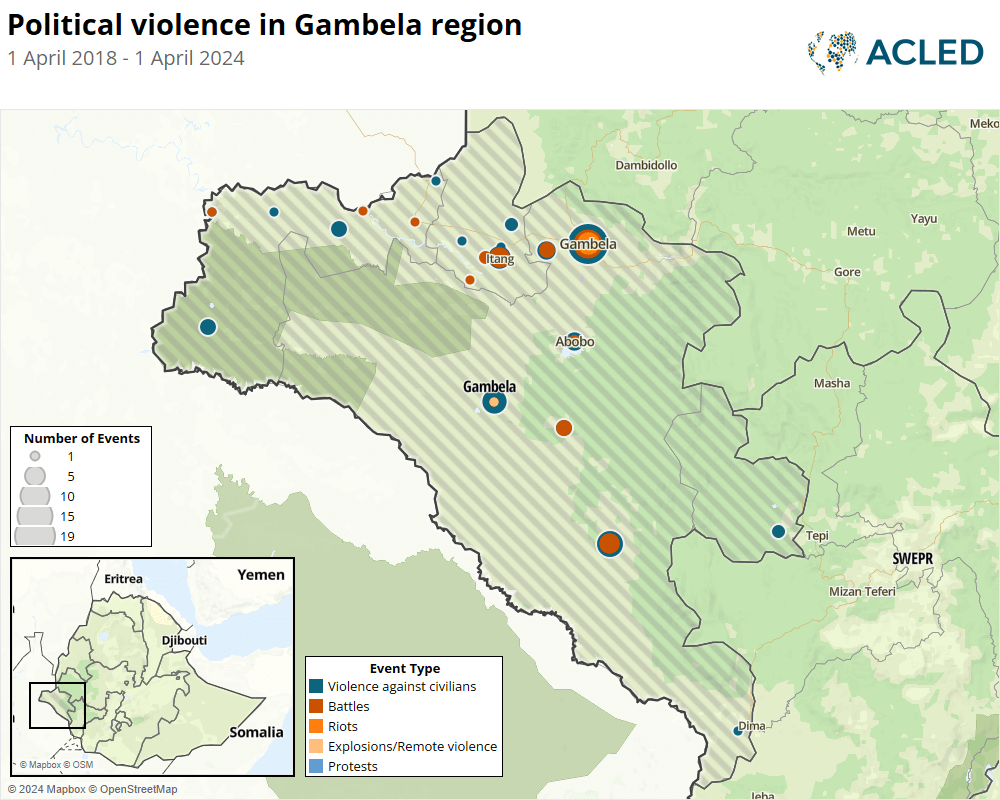Last updated: 08/08/2024
Gambela is located in southwestern Ethiopia, bordered by South Sudan in the west, Oromia Region in the northeast, and South West Ethiopia Peoples region in the southeast. The region’s capital city is Gambela and is divided into four administrative zones: Agnewak-zone, Nuwer-zone, Mezhenger-zone, and Etang Special zone. Within these four zones, there are 13 woredas. Based on the last census conducted in 2007, Gambela region’s population was over 300,000,1United Nations High Commissioner for Refugees: Operational Data Portal, ’Refugees from South Sudan: Ethiopia,’ retrieved on 10 april 2024 with five ethnic groups that are considered indigenous. These are the Anywaa (or Anyuak), Komo, Majanger, Nuer, and Opo people. There are also people from other ethnic groups of the country living in the region, often called ‘highlanders’ (or Degenga). Among these inhabitants of the region, the Nuer and the Anywaa are the two largest groups, followed by the highlanders. The Nuer ethnic group is primarily agro-pastoralist, while the Anywaa ethnic group engages in cultivation. As of February 2024, the region hosts 386,063 refugees from South Sudan.2United Nations High Commissioner for Refugees, ‘UNHCR Ethiopia | Gambella Infographics July 2020,’ 31 July 2020 The working language is Amharic, but Nuer, Anywaa, and Afaan Oromo languages are also spoken in the region.
The region is administered by the formerly Ethiopian People’s Revolutionary Democratic Front (EPRDF)-affiliated political party, the Gambela People’s Democratic Movement (GPDM, የጋምቤላ ሕዝቦች ዴሞክራሲያዊ ንቅናቄ), which in December 2019 became the Prosperity Party (PP), Ethiopia’s ruling party. GPDM was established in 2003 after a violent ethnic-based power struggle within the previous political party, the Gambela People’s Democratic Front (GPDF). To resolve this conflict, the regional ruling party, EPRDF, established GPDM as a coalition of three ethnic-based parties: the Nuer People’s Democratic Organization to represent the Nuer and Opo ethnic groups, the Anywaa People’s Democratic Organization to represent the Anywaa and Komo ethnic groups, and the Majanger People’s Democratic Organization to represent the Majangir.
Like other regions in the country, Gambela region hosts an active anti-government insurgent group. The Gambela People’s Liberation Army (GPLA, Amharic የጋምቤላ ነጻነት ግንባር (ጋነግ) – Gambela Liberation Front) is a relatively new organization that was founded in October 2021 after the 2021 Ethiopian national elections. Citing electoral “irregularities and malpractices,” the group armed itself and announced it was dedicated to overthrowing the Gambela regional government.3Ethiopia Autonomous Media, ‘Announcement on Establishment of Gambela Liberation Front,’ 31 October 2021 The GPLA is part of a coalition of nine anti-government factions called the United Front of Ethiopian Federalism and Confederalist Forces (for more details on the anti-government alliance, see the EPO Monthly: November 2021).
The GPLA is not particularly active, with a few notable exceptions. In June 2022, the GPLA conducted a joint operation alongside fighters from the Oromo Liberation Army and took partial control of the capital city for several hours.4Addis Standard, ‘Gov’t forces engaged with Gambella, Oromo armed groups in ongoing exchange of gunfire in Gambella city; gunshots heard in two towns in Western Oromia,’ 14 June 2022 The Ethiopian Human Rights Commission released a report documenting evidence that at least 50 civilians were shot and killed by regional security forces following the attack5Ethiopia Human Rights Commission, ‘In the city of Gambella, the security forces of the region, the Oromo Liberation Army (ONG Shene) and Gambella Liberation Front (GANG) militants committed Human rights violations Investigation report,’ 28 September 2022 (for more, see the EPO Weekly: 11-17 June 2022).
However, the leadership of the GPLA announced that the group had “completely withdrawn from armed struggle,” committing hundreds of fighters to rehabilitation camps after disarming during the last two weeks of April 2023.6Negasa Desalegn, Tamirat Dinsa, and Negash Mohamed, ‘It was announced that the Gambella Liberation Front has completely withdrawn from the armed struggle,’ Deutsche Welle Amharic, 26 April 2023
Besides an active insurgency, Gambela region has historically hosted multiple violent conflicts, largely caused by tensions due to multi-layered inter-ethnic, intra-ethnic, and indigenous vs. highlanders conflicts (see map below). The civil war in South Sudan also has a spillover effect in the Gambela region due to shared communities. Furthermore, there are frequent raids and abductions of mostly children by an armed group from South Sudan, mostly by Murle ethnic militias from South Sudan.7Al Jazeera, ‘Ethiopia reports deadly raid by gunmen from South Sudan,’ 15 March 2017; BBC, ‘Ethiopia army ‘locates children abducted from Gambella,’ 21 April 2016; CGTN, ‘Ethiopia Gambella abductions: 88 kidnapped children reunited with families,’ 7 June 2016 It is believed that this group is from the Murle community.8Al Jazeera, ‘Ethiopia reports deadly raid by gunmen from South Sudan,’ 15 March 2017; BBC, ‘Ethiopia army ‘locates children abducted from Gambella’, 21 April 2016; CGTN, ‘Ethiopia Gambella abductions: 88 kidnapped children reunited with families,’ 7 June 2016

ACLED regularly records incidents of armed clashes in connection with cross-border raids on the region. Clashes, riots, and occasional protests are also sporadically reported in and around refugee camps in the area.

